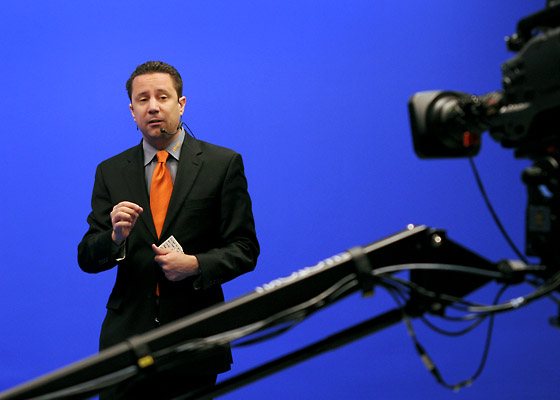Has the time for virtual come?
Subscribe to NewscastStudio for the latest news, project case studies and product announcements in broadcast technology, creative design and engineering delivered to your inbox.
During the 2009 NAB Show, NewscastStudio’s Michael P. Hill wrote, “Fully immersive and interactive 3D environments are becoming more and more popular but are still outside the reach of many local TV stations.”
This statement has continued to hold true, as local stations are still opposed to virtual sets, until maybe now?“Funny there are more virtual scenic companies here at NAB than traditional design companies,” writes Mack McLaughlin, CEO and creative director of FX Design Group. “The difference this year though is that in talking with station engineers and GMs here at the show, it’s the first time in a long time that they are actually talking about virtual systems as a viable option for local news production.”
In other parts of the world, including overseas and in Canada, virtual sets are becoming the first choice. In Canada, Global TV has rolled out virtual sets at many of its local stations.
McLaughlin lays out multiple reasons to go virtual, including: reduced costs, more creative flexibility, its greener and can possibly save* money. The asterisk is there for a reason, it can save money, but the top of the line solutions still cost upwards of $500,000.
So, what is the price point where local stations will start to pay attention? Right now, it appears to be somewhere under $100,000, or the cost of a midsized physical set. On top of cost, you also have the virtual aspect to combat.
How will talent take presenting on a green cyc?
“The preconception that a production can use hard and VR sets interchangeably leads to disappointment when the visuals don’t meet the expectation,” said David Hoffman, formerly of Brainstorm America, in a NewscastStudio interview. “While technology is quickly advancing to the point where it can support visually convincing sets, I see VR as more of a complement or augmentation to hard set productions.”
The technology is there and is being used on the network and cable channel level. The technology is at the local level, used in a simpler version, but how long until a station takes the leap into a fully virtual newscast? A newscast with nothing but a desk and a green wall.
“With many stations moving toward fixed camera peds greatly reducing the amount of movement in camera shots, for them we are recommending 3D digital designs that allow you to do multiple cameras in a fixed 3D digital environment,” writes McLaughlin. “There is no extra technology to purchase and this can be done while designing your main set elements, this is as simple as keying in your weather standups.”
Using just a chroma key wall, you can create a polished virtual product, with less cost.
This is the current entryway for virtual, a weather wall on steroids.

Right now, many local stations use virtual to extend sets, adding standup, entertainment and sports areas. Fox has done this for many local O&Os, adding a technology filled standup area that would have cost thousands to build.
With many stations looking to reduce costs, will virtual now see a place? Will it be part of the mix of visual presentation options, or will a local station take the jump and go completely virtual?
We’re not going to see systems similar to those used by CNN and NBC News on election night at the local level anytime soon, however, we may begin to see local stations taking advantage of virtual backgrounds to extend current sets.
Subscribe to NewscastStudio for the latest news, project case studies and product announcements in broadcast technology, creative design and engineering delivered to your inbox.





tags
soft set, virtual, virtual set, virtual set design
categories
Local News, Set Design